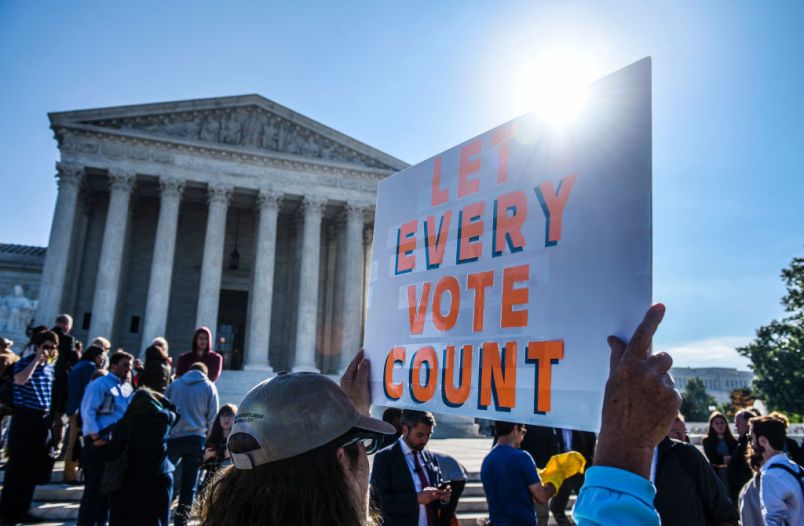HARRISBURG, Pa. (AP) — Republican leaders of the Pennsylvania Legislature on Friday produced a new proposed map of the state’s congressional districts, three weeks after the state Supreme Court declared the former map unconstitutional.
News: Here's the new congressional map Pennsylvania Republicans are proposing to Gov. Tom Wolf. Map currently in place was declared unconstitutional under PA state constitution. Gov. has until Thursday to approve or veto it. pic.twitter.com/UB2Oahuk7k
— Sam Levine (@srl) February 10, 2018
The proposal drafted by House Speaker Mike Turzai and Senate President Pro Tempore Joe Scarnati would make widespread changes, eliminating dozens of municipal and county divisions while keeping nearly 70 percent of residents in their old districts.
They forwarded the map and other materials to Democratic Gov. Tom Wolf, who has until Thursday to tell the justices if he supports it. If not, the court has indicated it will develop its own map.
Scarnati’s top aide, Drew Crompton, told reporters he was confident the draft met standards outlined in the majority opinion released two days earlier.
“Unless the Supreme Court changes the rules again, that map is per se constitutional,” Crompton said.
Some — if not many — of the finer points of the old map that have drawn criticism were addressed. The map puts several cities that had been split into single districts, including Erie and Harrisburg. Easton would be rejoined to other parts of the Lehigh Valley.
A suburban Philadelphia district whose sprawling shape has drawn comparisons to the cartoon characters Goofy kicking Donald Duck looks much more compact. Populous Montgomery County in the suburbs would be divided among four districts, rather than five. Crompton said its size meant it may not be possible to split it fewer than three ways.
Wolf’s spokesman said the governor and his redistricting team will review the map, adding that an update before Monday was unlikely.
“The original map was fundamentally unfair in a multitude of ways and, from the court’s orders and majority opinion, it is clear the gerrymandering of the current map went beyond manipulating the shape of the districts,” said Wolf press secretary J.J. Abbott.
Crompton said the map will be turned into legislation but a decision about whether to bring it up for floor votes early next week will partially depend on the response from Wolf.
Democratic leaders in the Legislature promptly released a letter sent to Wolf, urging him to reject the map because it was a product of the two Republican leaders, as opposed to the General Assembly as a body.
They argued that violated the court order’s discussion of “enactment of a remedial congressional districting plan.”
“The Republican leadership in both chambers blocked this process, refused to negotiate and have now submitted a map directly to your office that we have not even seen,” wrote Senate Minority Leader Jay Costa and House Minority Leader Frank Dermody.
The GOP-drawn map passed in 2011 has been a political winner for Republicans, giving them a 13-5 advantage in three straight elections in a state with more registered Democrats than Republicans.
The decision by the Democratic majority on the court to throw out the map has raised Democrats’ hopes that different districts could help them flip enough seats to retake the majority in Congress.
“The unknown at this point is what kind of partisan split could be predicted from these districts,” said House Democratic spokesman Bill Patton. “A 9-9 balance in a state like this would be fairest.”
The Republican leaders said their map splits only 32 counties and municipalities, 62 fewer than the 2011 map. It maintains a majority-minority district in Philadelphia and increases the minority numbers in a second city district.
The court’s majority opinion issued Jan. 22 said the plan violates a provision of the state constitution that guarantees “free and equal” elections, subverting redistricting objectives such as compactness and minimal municipal splits to the goal of gaining partisan advantage.
The court has said a new map will be in place by Feb. 19. It will be used for the May 15 primary, but not for the March 13 special election to fill a vacant congressional seat in southwestern Pennsylvania.







It will be VERY interesting to see what the geographers have to say about it after they run it through their test programs.
The Repubs are relentless in their corruption.
It has been ever so since at least Nixon.
Trying to figure out how much of an effect it will have on House seats. I compared the proposed map with one I found by outlining he counties with a higher number of registered democrats than republicans.
Might lose PA’s17th and gain the 3rd. If Dems turn out in the west it could put 12 and 18 in play. Pretty sure we pick up 7 and 8 in the south east. 6 could be a real possibility too. Best case scenerio +5 seats?
This article is failing to mention the related story that the PA Republicans are threatening to impeach all 5 of the PA State Supreme Court justices who voted against their original gerrymandered map and they have enough of a majority in the legislature to do it. Keep in mind, the new map may not have been drawn up fairly on purpose, so they have an excuse to impeach those judges that won’t let them cheat and steal their hold on power.